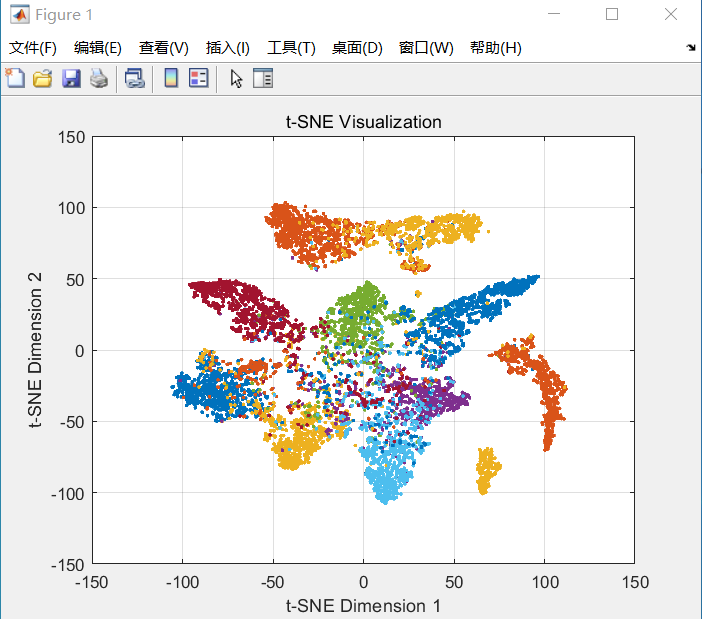在cifar-10数据集上t-sne可视化效果最好(๑•̀ㅂ•́)و✧
还是需要在python上面保存模型,加载模型,然后提取特征保存为mat文件就行了(但我现在只加载了64维特征,4096维特征还没试过,估计也可以但应该会又慢又不好看)
①先放matlab可视化t-sne的代码
% 加载特征数据 data = load('10_157_ckpt.pth.mat'); features = data.features; labels = data.labels; % 执行 t-SNE 降维 % 这里的参数可以根据你的需求进行调整 X_reduced = tsne(features, 'Algorithm', 'exact', 'NumDimensions', 2, 'Perplexity', 30); % 绘制 t-SNE 可视化图 figure; gscatter(X_reduced(:,1), X_reduced(:,2), labels); title('t-SNE Visualization'); xlabel('t-SNE Dimension 1'); ylabel('t-SNE Dimension 2'); legend('Location', 'best'); grid on;
效果

②读取模型,提取特征保存为mat(现在不太推荐了)
import torch from torch.utils.data import DataLoader from cifar.resnet import ResNet32 from cifar.data_utils import * import numpy as np import scipy.io # 设置参数 batch_size = 100 checkpoint_path = '//home/zy/pycharm/project/MetaSAug-main/ImageNet_iNat/models/resnet50_uniform_e90.pth.tar' # 模型的路径,你需要替换成你保存的模型的路径 output_file = '/home/zy/pycharm/project/MetaSAug-main/yangzy/TEST_159_ckpte90.pth.mat' # 特征保存的文件名,可以是.mat格式 # 建立数据加载器 _, train_dataset, test_dataset = build_dataset('cifar100', 100) # 假设你使用的是CIFAR-100数据集 train_loader = torch.utils.data.DataLoader( train_dataset, batch_size=batch_size, shuffle=True) test_loader = DataLoader(test_dataset, batch_size=batch_size, shuffle=False) # 建立模型 model = ResNet32(num_classes=100) # 假设你使用的是CIFAR-100数据集 checkpoint = torch.load(checkpoint_path) model.load_state_dict(checkpoint['state_dict']) model.eval() # 设置设备 device = torch.device('cuda' if torch.cuda.is_available() else 'cpu') model = model.to(device) # 提取特征 features_list = [] labels_list = [] with torch.no_grad(): for inputs, labels in test_loader: inputs = inputs.to(device) # 使用模型前向传播获取特征 features, _ = model(inputs, 4096) features_list.append(features.cpu().numpy()) labels_list.append(labels.numpy()) # 将特征保存为.mat文件 features_array = np.concatenate(features_list, axis=0) labels_array = np.concatenate(labels_list, axis=0) output_dict = {'features': features_array, 'labels': labels_array} scipy.io.savemat(output_file, output_dict) print("Features saved to", output_file)
本文作者:太好了还有脑子可以用
本文链接:https://www.cnblogs.com/ZarkY/p/18082587
版权声明:本作品采用知识共享署名-非商业性使用-禁止演绎 2.5 中国大陆许可协议进行许可。




【推荐】国内首个AI IDE,深度理解中文开发场景,立即下载体验Trae
【推荐】编程新体验,更懂你的AI,立即体验豆包MarsCode编程助手
【推荐】抖音旗下AI助手豆包,你的智能百科全书,全免费不限次数
【推荐】轻量又高性能的 SSH 工具 IShell:AI 加持,快人一步
2023-03-19 nb复试上机题